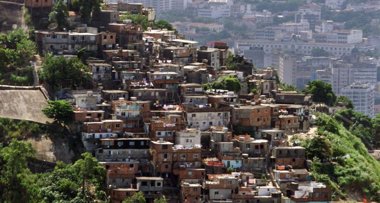BRASILIA, May 4. Some 16.2 million Brazilians live in extreme poverty, which is equivalent to 8.5 percent of the population of the South American country, reveals the latest report from the Brazilian Institute of Geography and Statistics (IBGE). This indicator is included families with a monthly income equal to or less than 70 reais (about 30 euros), following the United Nations.
Of the total, an estimated 11.4 million people are in this range, while 4.8 million have no income. In addition, the IBGE has taken into account other variables such as the existence of bathrooms in homes, access to water and electricity supplies and the literacy level of members of the family.
According to the report, some 300,000 households lack basic services. "The lower the personal income, the greater the proportion of people without access to drinking water, the lower the income, the greater the proportion of the population has no toilet at home. In rural areas the situation is recurring, "said the director of the IBGE, Eduardo Nunes.
The study also provides a profile of people living in extreme poverty. Most are younger than 19 years (50.9 percent) black (70.8 percent) living in the countryside (46.7 percent), where one in four people are in a situation misery, and the city (53.3 percent). Just sex differences are appreciated, because this phenomenon affects women almost equally (50.5 percent) and men (49.5 percent).
These percentages when it comes to distance from urban areas, where the situation of the women is worse. By region, 60 percent is concentrated in the Northeast, which is equivalent to 9.61 million people, although their presence is also important in the Southeast with 2.7 million, in the north with 2.65 million; in the south with 715,000, and the central-to 557,000, as recorded by Agency of Brazil.
CONTINGENCY PLAN This report, drawn from the population census data of last year, will support the Government of Dilma Rousseff to design the Brazil Without Poverty Plan, which aims to eradicate extreme poverty by 2014. The Minister of Social Development and Hunger Alleviation, Tereza Campello, explained that this program includes a transfer of income to the less affluent classes, better training, as well as an extension of basic public services.
"This is not to develop new programs, but to address this audience. We will not make a call, we will ensure that the country falls in this population. This is a great effort for federal, state and city, "said the minister, referring to previous plans as Bolsa Familia. 


Of the total, an estimated 11.4 million people are in this range, while 4.8 million have no income. In addition, the IBGE has taken into account other variables such as the existence of bathrooms in homes, access to water and electricity supplies and the literacy level of members of the family.
According to the report, some 300,000 households lack basic services. "The lower the personal income, the greater the proportion of people without access to drinking water, the lower the income, the greater the proportion of the population has no toilet at home. In rural areas the situation is recurring, "said the director of the IBGE, Eduardo Nunes.
The study also provides a profile of people living in extreme poverty. Most are younger than 19 years (50.9 percent) black (70.8 percent) living in the countryside (46.7 percent), where one in four people are in a situation misery, and the city (53.3 percent). Just sex differences are appreciated, because this phenomenon affects women almost equally (50.5 percent) and men (49.5 percent).
These percentages when it comes to distance from urban areas, where the situation of the women is worse. By region, 60 percent is concentrated in the Northeast, which is equivalent to 9.61 million people, although their presence is also important in the Southeast with 2.7 million, in the north with 2.65 million; in the south with 715,000, and the central-to 557,000, as recorded by Agency of Brazil.
CONTINGENCY PLAN This report, drawn from the population census data of last year, will support the Government of Dilma Rousseff to design the Brazil Without Poverty Plan, which aims to eradicate extreme poverty by 2014. The Minister of Social Development and Hunger Alleviation, Tereza Campello, explained that this program includes a transfer of income to the less affluent classes, better training, as well as an extension of basic public services.
"This is not to develop new programs, but to address this audience. We will not make a call, we will ensure that the country falls in this population. This is a great effort for federal, state and city, "said the minister, referring to previous plans as Bolsa Familia.


- Proving extrema using taylor series and Hessian Matrix (01/05/2011)
- Proving extrema using taylor series and Hessian Matrix (01/05/2011)
- Nike Brasil & France Federation Board Shorts (29/04/2011)
- Exclusive: Mario Testino Shoots Kate Moss For Vogue Brasil (29/04/2011)
- Lessons from my own Country - Lecciones de mi Tierra (18/02/2011)
No comments:
Post a Comment